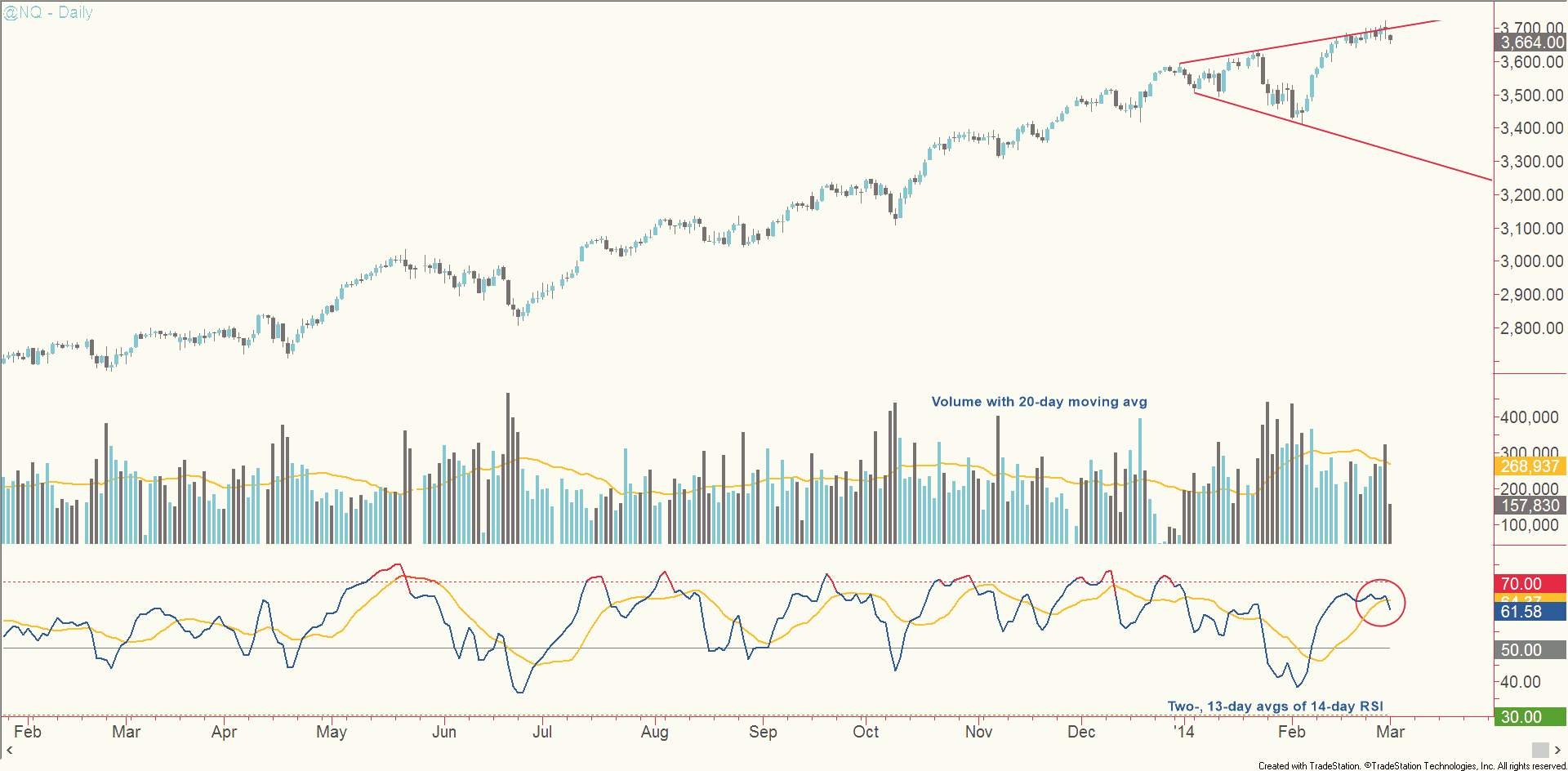 Stocks managed an impressive upswing off their early February lows, rewarding those who continued to buy the dip. I stayed cautious throughout based on slowing momentum on the weekly chart of the S&P 500, and indeed missed the move (markets do often grind higher even as the pace of the advance slows). I’m at peace with that: until I can start predicting the future, I’ll continue to put capital at risk only when I see very good odds of success, and sit antsily watching the rest of the time. Today, I’ll turn my attention to the NASDAQ 100 Index.
Stocks managed an impressive upswing off their early February lows, rewarding those who continued to buy the dip. I stayed cautious throughout based on slowing momentum on the weekly chart of the S&P 500, and indeed missed the move (markets do often grind higher even as the pace of the advance slows). I’m at peace with that: until I can start predicting the future, I’ll continue to put capital at risk only when I see very good odds of success, and sit antsily watching the rest of the time. Today, I’ll turn my attention to the NASDAQ 100 Index.
Focusing on a swing trader’s time frame of about two days to two weeks, if you’ve profited from the recent run, you’d do well to at least take a partial profit here. If you have a high risk tolerance, you could consider a short (or long put) position here, keeping in mind you’d be trading against the larger trend and so would want to keep your position size small and expectations modest.
NASDAQ 100 Presses Top of Megaphone
Since its high on the last day of 2013, the NASDAQ 100 has been tracing out a megaphone formation (also known as a broadening pattern or inverted triangle). I’ve drawn red lines on the chart to indicate the upper and lower barriers of the pattern. Technical analysis textbooks tend to focus on how this pattern acts as a top. I’ve also seen it act as a continuation pattern – the trend that preceded it ultimately continues – plenty of times. If you’re a swing trader, you shouldn’t be concerned over whether this is a top or a consolidation. The bottom line is that NASDAQ 100 has been pressing the upper barrier since 2/18 without punching through, and today’s drop beneath last week’s lows points to a heightened risk of a leg down in the coming days, possibly weeks.
Volume Pattern Concerning
I’m a big believer that you can ignore volume much of the time. Consider, falling volume during an uptrend can be an indication of ease of movement, meaning not much volume is required to keep price going higher because there’s such a lack of selling interest, a sign of technical strength. That’s a very different story from a bearish divergence between price and volume, which is bearish. If you can’t confidently tell the difference, leave it alone and focus on price.
That said, in come cases, volume tells an important story. And I think it does right now. The sell-off in late January was accompanied by a surge in volume (note how far above the 20-day volume moving average the dark gray bars stretched). By the last days of the month and the first week of February, some big up volume days (light blue bars) pointed to buying into weakness. Sure enough, a low was established on 2/5 and the market took off.
Now fast forward to the past two weeks. The 20-day volume moving average (orange line) has been receding markedly since 2/20, about the time NASDAQ 100 started consolidating gains. What’s this telling us? Institutional buying took place near the bottom on 2/5, as indicated by the volume spike then. That portion of the crowd, which has the greatest influence on the market’s direction, then stepped aside to let the retail crowd chase the move. As the NASDAQ 100 tested the top of the megaphone, volume dried up and supply and demand came into balance as the bulls grew less willing to buy at higher prices. Friday’s volume spike occurred on a day when price closed within a recent range – often a warning sign by showing that a great effort didn’t suffice to push the market to sustained higher highs. And the index is falling today
Momentum Close to a Bearish Turn
This is the last piece of the puzzle. I measure momentum with moving averages of the 14-day relative strength index. On 2/18, the fast average (dark blue line) started to move sideways; it will decline significantly today unless stocks recover by the end of the session. More importantly, the slow average (orange line) will turn down today for the first time since 2/11 unless the market bounces back. Turns in the slow average often occur when a recent swing is reversing. The fact that this turn would coincide with selling at the top of the NASDAQ 100 megaphone and evidence of softer demand in volume enhances reason for caution.
Context
I stress that this is a very granular analysis and applies only to a swing trader’s time frame. I’m by no means suggesting position traders or investors should go short here. I do some position trades myself and with regard to exchange traded funds that pace the broader market, I don’t like stocks here. With the NASDAQ 100 trading in a megaphone, I wouldn’t be surprised to see a sideways trend in the near term. But it could be a good time for swing traders who are comfortable reversing direction pretty quickly.
With that, I bid you good trading and hope for a calm day if you happen to home with the kids as I am amid yet more snow.
No positions in any mentioned securities at the time of publication. Any opinions expressed herein are solely those of the author, and do not in any way represent the views or opinions of any other person or entity.









